Novel Hollow Fiber Sandwich Composite Post System: Mechanical Characteristics
ABSTRACT
BACKGROUND: There is currently no consensus on the optimal post system to provide effective long-term results. We used an engineering approach to investigate the mechanical properties of a sandwich hollow carbon fiber post in synergy with a new bonding technique. Further details about composite tooth restoration after endodontics are accessible for you to learn in Giovanni Cavalli author's course "Post Endodontic Restoration: from root canal preparation to occlusal check".
METHODS: We studied two systems — a sandwich fiber hollow post (Techole®, Isasan, Como, Italy) composed of carbon fiber incorporated in a Dpp-MOR resin mix and a traditional non-hollow post (Tech 2000®, Isasan, Como, Italy). A bi-component composite (Clearfil Core®, Kuraray, New York, NY, USA) (2.2 gcm3, 12.3 GPa) and a dual cure composite with lower density and modulus of elasticity (Clearfil DC Core®, Kuraray, New York, NY, USA) (2.0 gcm3, 10.0 GPa) were also used into hollow posts. Results from three-point bending test (N.=81), compression test (N.=78) and cut test (N.=81) were achieved.
RESULTS: In the three-point bending test there were significant differences in flexibility/bending when sandwich fiber hollow posts were filled with composite of different modulus of elasticity. Hollow sandwich posts showed also significant (P=0.000) better resistance to compression and cutting than solid posts, independently of the type of composite. Moreover, hollow posts filled plus composite with a modulus of elasticity of 12.3 GPa showed significant (P=0.000) improved resistance parameters rather than hollow posts filled with a composite of 10.0 GPa.
CONCLUSIONS: The study confirms the favorable mechanical properties of the hollow sandwich fiber post system (Techole®) and the synergistic efficacy when used in combination with the composite Clearfil DC Core® (10.0 GPa) and, especially, Clearfil Core® (12.3 GPa).
INTRODUCTION
The aims of endodontic interventions are manifold — to restore normal form and function, protect the residual tooth structure while, at the same time, maintaining good aesthetics.[1, 2] Success depends on the use of operative procedures and materials appropriate to a given clinical situation. Where there is insufficient coronal tooth structure, intracanal posts are indicated to promote retention of the restorative material and reinforce the residual structure to ensure force distribution along the root.[3] The amount of tooth structure remaining is important in determining the resistance to fracture.[4] Selection of the appropriate type of post is paramount in reducing the incidence of root fractures and preserving the root in case of failure. Therefore the ideal post system should be fracture resistant, optimize retention and be able to withstand the normal forces involved in mastication.[5, 6] The post should have a similar modulus of elasticity to root dentin, in order to distribute forces consistently along the length of the post itself and of the root.
Traditionally endodontically-treated teeth were restored using metal posts with a higher modulus of elasticity than the dentin, which meant they frequently failed. This led researchers to investigate other types of materials with a modulus of elasticity closer to that of dentin to ensure greater flexibility and stress distribution.[7, 8] Since the 1990s, a new generation of fiber posts that permits better absorption and dissipation of loads and higher fracture strength has been clinically used. Although there is a substantial good evidence on the use of fiber posts, the majority of data comes from in-vitro studies. The limited published clinical trials data show reasonably good survival rates with post systems, but there is an increased clinical need to ensure adequate movement of the core during normal function.[8, 9] Results of the first long-term, controlled randomized pilot trial showed favorable survival rates of restored endodontically treated teeth irrespective of the post material used (glass fiber vs. titanium).[10] Reasons for failure include secondary caries, loss of retention, debonding of the post and crown and distortion/fracture of roots and posts.[11, 12] Microleakage under the crown is also a potential problem — a post can have a similar modulus of elasticity but because the root is thinner it may flex more under a given load.[13, 14]
In recent years major advances have been reached both in the type of retentive posts used (cemented, friction-locked posts, self-threading posts), and in the pretreatments and materials employed. The basic premise is to maximize bonding between the post and the composite material.[15] Surface treatment of posts is often used to provide chemical and/or mechanical interaction between the post and surrounding composite.[16] Etching techniques with, for example, hydrofluoric acid, potassium permanganate, silane and hydrogen peroxide are helpful to enhance the surface roughness and increase bond strength between posts and composite.[17-20] Agents such as 10-methacryloxydecyl dihydrogen phosphate (10-MDP), an acidic functional monomer used in self-etch adhesives that tightly bonds to calcium, are also used with encouraging results.[21, 22]
Despite these advances, there is no consensus on the optimal post system to provide effective long-term results: therefore the problem should be approached from a different perspective, furthermore new techniques and combinations of materials need to be adapted into the daily dental practice. Hollow composite carbon-fiber tubing systems are used extensively in non-medical industries such the aerospace and marine industries, as they are flexible, can be bent to shape and filled with bonding material on site to increase force resistance. The same system could be applied in the endodontic field; in particular, mechanical properties of a novel sandwich composite hollow carbon fiber post should be investigated in synergy with a new bonding technique in a dedicated dental laboratory.
Hollow sandwich composite fiber posts are composed of fiber tubes filled with resin composite that on cross section are evidenced by two external layers (called skin) separated from the core, which develops along the whole main axis of post itself (Figure 1). The function of the core is to maintain a distance between the two skin layers. The application of this concept to a tubular structure means that the advantages of the sandwich effect can be transposed along the entire length of a tubular structure of any diameter, which increases not only the resistance to compression but also the shear of the fibers in the peripheral part of the tooth. The confinement action exerted by the fiber-reinforced polymers (FRP) on the core arises as a result of the lateral expansion under axial load. As the axial stress increases, the corresponding lateral strain/load increases and the confining device develops a tensile hoop stress balanced by a uniform radial pressure, which reacts against lateral expansion.[23] For circular columns, the cement is subject to uniform confinement, and the maximum confining pressure provided by FRP is related to the volume and strength of the FRP and the diameter of the confined composite core (Figure 2). The maximum confining pressure is reached when the circumferential tension on the FRP increases to such an extent that the fibers rupture ultimately results in a collapse of the cylinder. Filling the tubular fiber post with composite during the cementation process confers a number of important advantages: the sandwich concept allows the qualities and characteristics of each of the individual materials to be maximized; furthermore cementation is simplified as the post is at the same time the needle that extrudes composite. Moreover, the composite material is inserted when the post has already been placed into the canal, which allows the position of the post to be controlled inside the canal before the injection of composite, thereby ensuring that the cementation process is careful and optimized and formation of air bubbles is avoided.
Instead, incorporation of air bubbles using traditional techniques takes place both during the filling of the canal with the composite, because of the extraction of the needle while the material is extruded, and during the insertion of the post, which is an air carrier too. Air bubbles are a locus minoris resistentiae and could compromise the post-composite complex and its adhesion to the “post-space” dentin.
In the present in-vitro study an engineering approach was employed:
to compare the mechanical properties of a hollow sandwich composite carbon fiber post and a traditional solid carbon fiber post (control);
to compare the resistance properties of two composites with different modulus of elasticity in the sandwich;
to evaluate the clinical advantages of using a novel technique whereby the post is a carrier for the resin cement at the base of the ‘post-space’.
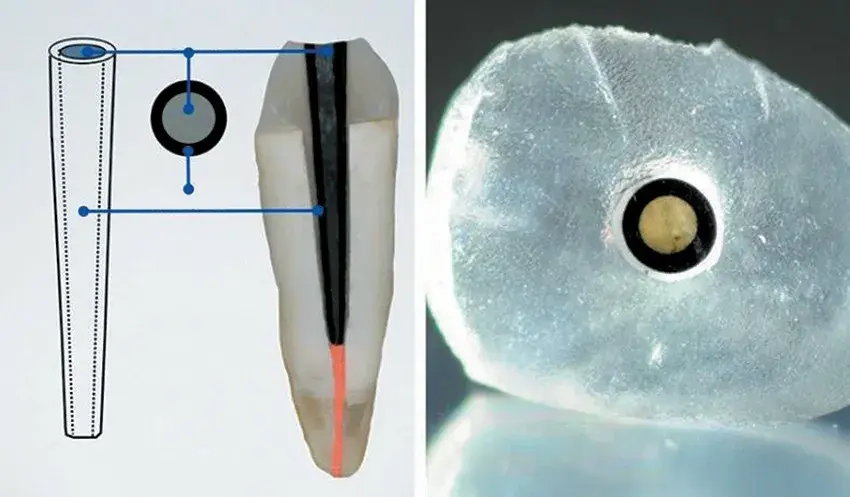 Figure 1.—Sandwich composite post.
Figure 1.—Sandwich composite post.
 Figure 2.—Confinement action of fiber reinforced polymers (FRP) jacket in circular sections.
Figure 2.—Confinement action of fiber reinforced polymers (FRP) jacket in circular sections.
MATERIALS AND METHODS
Materials
Two different post systems were investigated:
the traditional non-hollow post Tech 2000® (Isasan, Rovello Porro, Como, Italy) — composed of carbon fibers incorporated in a Dpp-MOR resin mix, so that a chemical bond can be created with composites, after using an adhesive system. This particular feature allows the post not only to make the reconstruction more stable, but also and above all, not to discharge forces on the root that presents an intrinsic degree of fragility as endodontically treated;
the sandwich fiber hol-low post Techole® (Isasan, Rovello Porro, Como, Italy) — composed of carbon fiber incorporated in a Dpp-MOR resin mix too. There is no longer need to fill the canal and then insert the post, but everything can be done with a single step as the post drives the composite into the canal.
The posts diameter has been uniformed to 1.4 mm; consequently, cylindrical posts were chosen, chamfered only at the tip, in order to exclude shape, taper and diameter variables. The hollow post, always 1.4 mm externally, was chosen with a lumen of 0.7 mm.
Two composite materials were used:
Clearfil Core® (Kuraray, New York, NY, USA) (12.3 GPa);
Clearfil DC Core® (Kuraray, New York, NY, USA) (10.0 GPa).
Clearfil Core® (Kuraray, New York, NY, USA) is a radiopaque, bi-component, self-curing chemical composite, with a density of 2.2 gcm3 and a modulus of elasticity of 12.3 GPa. The catalyst paste is composed of bisphenol A diglycidylmethacrylate (Bis-GMA), triethyleneglycol dimethacrylate (TEGDMA), silanated glass filler, colloidal silica and catalysts; whereas the universal paste consists of bisphenol A diglycidylmethacrylate (Bis-GMA), triethyleneglycol dimethacrylate (TEGDMA), silanated silica filler, colloidal silica and accelerators.
Clearfil DC Core® (Kuraray, New York, NY, USA) is a radiopaque dual cure composite, supplied in an automix delivery system, with both lower density (2.0 gcm3) and lower modulus of elasticity (10.0 GPa). Principal ingredients of paste A are bisphenol A diglycidylmethacrylate (Bis-GMA), hydrophobic aliphatic dimethacrylate, hydrophilic aliphatic dimethacrylate, hydrophobic aromatic dimethacrylate, silanated barium glass filler, silanated colloidal silica, colloidal silica, dl-camphorquinone, initiators and pigments. Paste B holds triethyleneglycol dimethacrylate, hydrophilic aliphatic dimethacrylate, hydrophobic aromatic dimethacrylate, silanated barium glass filler, silanated colloidal silica, aluminum oxide filler and accelerators.
Study design
Each post system (Techole® plus Clearfil Core®, Techole® plus Clearfil DC® and Tech 2000®) underwent the following mechanical tests: three-point bending test, compression test and cut test (Figure 3).
 Figure 3.—Study design. Each kind of post system underwent three-point bending test (A), compression (B) and cut (C) tests.
Figure 3.—Study design. Each kind of post system underwent three-point bending test (A), compression (B) and cut (C) tests.
Preparation of test materials
No preparation was necessary in the case of the traditional posts with the exception of examination under optical microscope to ensure there were no visible production defects. For the composite posts — the same operator performed injection of the composite in one sitting at ambient temperature under controlled humidity thanks to a controlled humidity chamber. The dual cure and chemical cure composite was just mixed using an automix to ensure that no air bubbles were incorporated and to improve its performance (samples were not light cured). When the composite was inserted, posts were maintained vertically for 24 hours to allow complete polymerization.
Experiments performation
Tests were carried out using the universal test machine Zwick/Roell Z150 (ZwickRoell, Kennesaw, GA, USA). Accuracy, precision and control both in positioning the sample to be tested and during the test, make this machine the most suitable for bio-mechanical and micro-mechanical tests in professional field and for companies.
The machine shows the following technical features: a speed from 0.00005 nm/min up to 900 mm/min; a test area width of 630 mm; a test area height of 1675 mm; a power rating of 5.5 kVA; a load cell from 600 N up to 3000 N. Functions are digital controlled, an innovative motor feedback system ensures excellent constant velocity properties, even at very low speeds, and a precise crosshead guidance minimizes undesirable mechanical influences on the specimen. The tool provides the ideal basis for precise, reproducible test results.
In the three-point bending test (Figure 4) the post was positioned in two metal supports 8 mm apart. The bending action was carried out by a single punch: its geometric radius (1.5 mm) was correlated to the thickness of the sample and it reached exactly the center line between the to supports. As the universal testing machine dropped onto the specimen at a speed of 0.5 mm/minute, the specimen would have fractured at a particular load (Figure 5). This maximum load before fracture (F) was given in Newtons in the display of the testing machine.
In the compression test (Figure 6), a sample was compressed between two flat and parallel surfaces, producing a deformation and a subsequent structural and mechanical failure (Figure 7) when above the maximum resistance level.
The most fragile materials are usually fractured more quickly than ductile ones, as they deform, modifying their initial morphology. In clinical practice, the compression test is even more significant than the three-points one, since the post is subjected to greater occlusal forces than the lateral ones. In this experiment, first of all, the posts were cut using a slow-speed diamond saw at 15 mm long in order to standardize their length, then they were located on a fixed support and loaded vertically at 0.5 mm/minute, to stress the structure both along the long axis of the tooth and along the direction of the carbon fibers.
The cut test studies the mechanical behavior of a material when the load is transverse to its major axis. Posts were partially and stably fixed horizontally; subsequently a movable strut dropped vertically at 0.5 mm and met them (Figure 8).
Thus both protrusive and laterality movements were also reproduced (Figure 9). Values of maximum mechanical resistance and the resulting curve were considered.
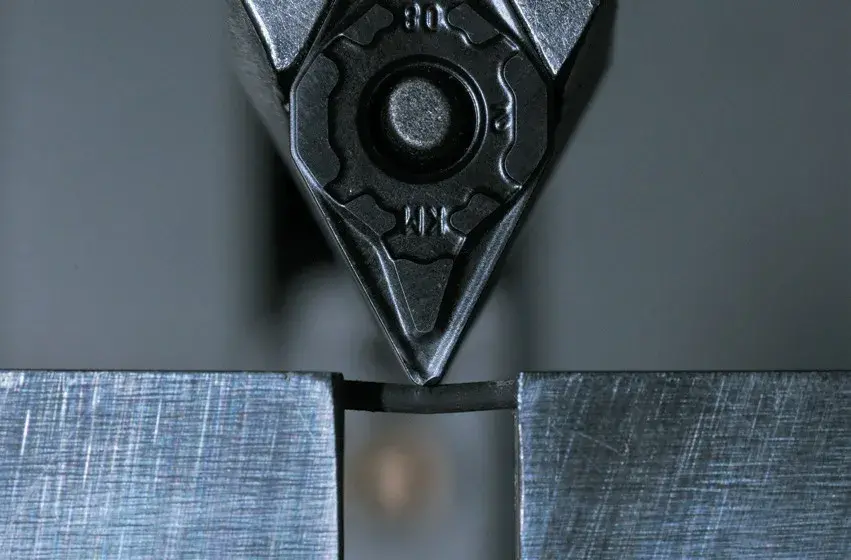 Figure 4.—In three-point bending test the post was positioned in two metal supports 8 mm apart and the bending action was carried out by a single punch.
Figure 4.—In three-point bending test the post was positioned in two metal supports 8 mm apart and the bending action was carried out by a single punch.
 Figure 5.—A post after a three-point bending test.
Figure 5.—A post after a three-point bending test.
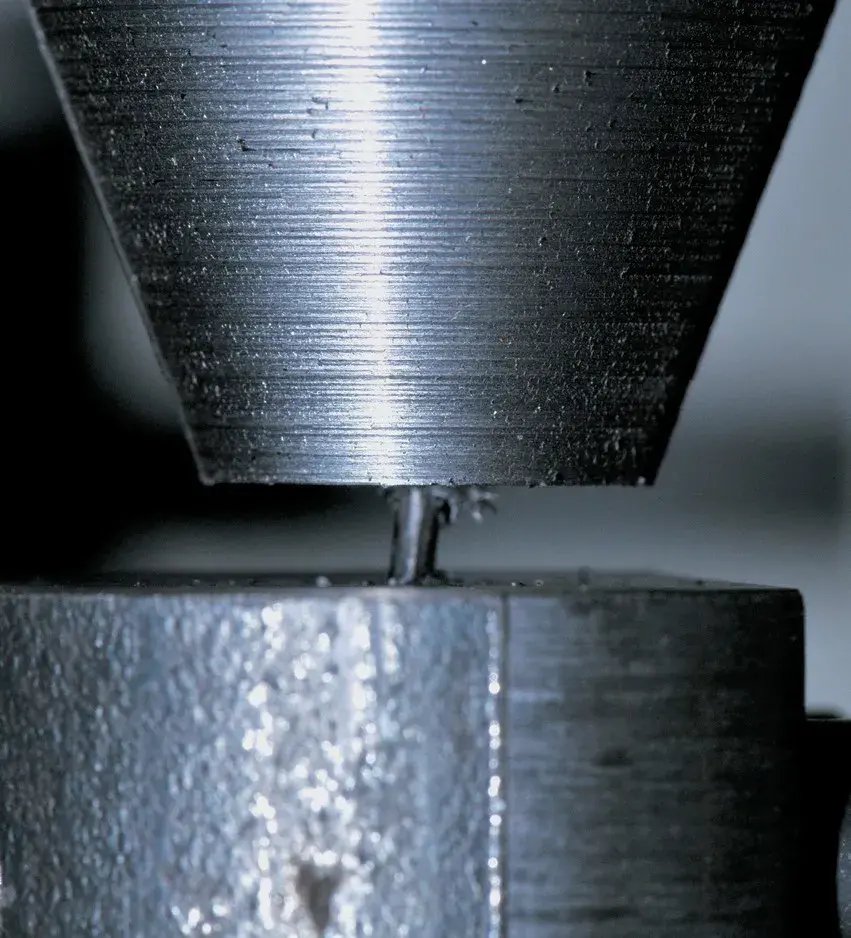 Figure 6.—In the compression test the post was compressed between two flat and parallel surfaces.
Figure 6.—In the compression test the post was compressed between two flat and parallel surfaces.
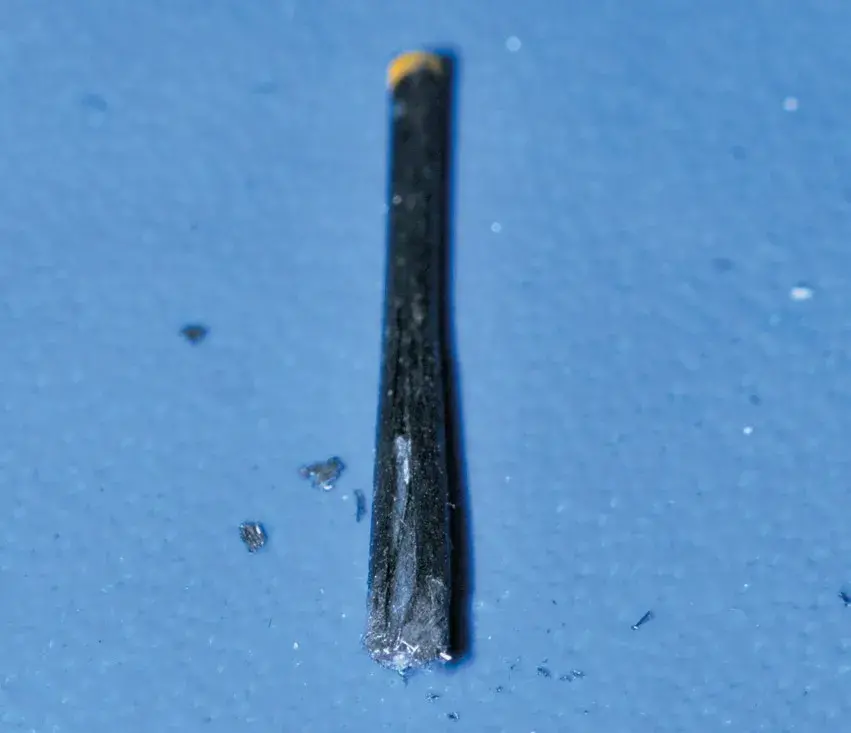 Figure 7.—A post after a compression test.
Figure 7.—A post after a compression test.
 Figure 8.—In the cut test the post was fixed horizontally and a movable strut vertically met it.
Figure 8.—In the cut test the post was fixed horizontally and a movable strut vertically met it.
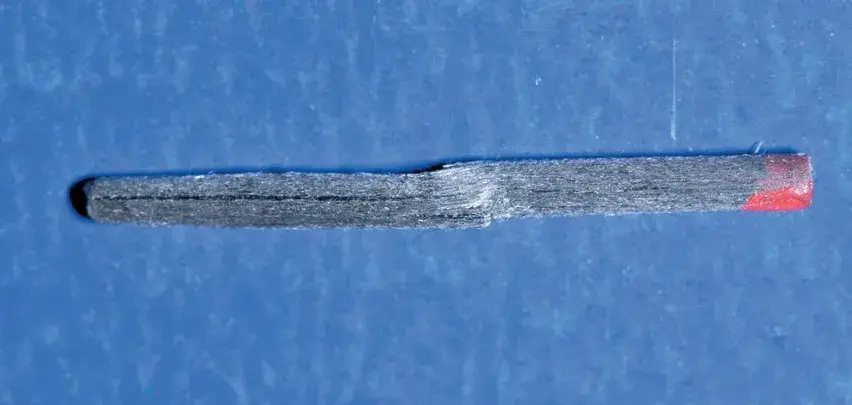 Figure 9.—A post after the cut test.
Figure 9.—A post after the cut test.
Statistical analysis
The mean value of the flexural strength of all the groups was computed and statistically analyzed using one-way analysis of variance (ANOVA) plus Tukey’s test (significance level P<0.005).
RESULTS
Overall, results show that sandwich fiber hollow post filled with composite with a modulus of elasticity of 12.3 GPa had the highest mechanical resistance in most tests (Table I, II, III).
In the three-point bending test, 81 samples were divided into three groups of 27 each one and were evaluated. Different results were obtained in the flexibility/bending when traditional post were used and when the hollow sandwich posts were filled with composite of different modulus of elasticity (Table I). The test showed that traditional posts have a better resistance when they are loaded perpendicularly to their long axis. While there were no significant differences between the Techole plus Clearfil Core® (12.3 GPa) and the traditional solid Tech 2000® post, meaning that the two samples have a similar and overlapping mechanical behavior, significant differences were instead observed between the Techole® plus Clearfil DC® (10.0 GPa) and the traditional posts: when using Techole® plus Clearfil DC Core® composite (10 GPa) values decrease, demonstrating that the elastic modulus of the filling is decisive in terms of resistance value.
For the compression test, 78 samples were divided into 3 groups of 26 elements. The Techole® posts showed statistically superior results compared with the traditional solid posts, with the hollow sandwich post with Clearfil® (12.3 GPa) showing the highest values (Table II).
Overall, independently of the type of composite used, hollow sandwich posts showed better resistance values compared with solid posts when they are subjected to compressive stresses along their long axis; moreover hollow posts filled with composite with the higher modulus of elasticity (12.3 GPa) showed improved resistance parameters. It has been shown again that elastic modulus of the filling material influences the resistance of the post plus filling material system.
Similarly, in the cut test, the 81 samples were divided into three groups of 27 posts. Also in this kind of test, the hollow sandwich carbon fiber post filled with Clearfil® 12.3 GPa had the highest and significant resistance of the three test groups followed by that containing Clearfil® 10.0 GPa (Table III). The combination of a hollow sandwich post (Techole®) and a composite with a high modulus of elasticity increased resistance parameters by over 15% compared with traditional solid posts (Tech 2000®). The Techole® combined with composite Clearfil DC® also showed superior results compared with the traditional solid post in terms of resistance to tension and transversal stresses and shear.
Table I.— Results of three-point bending test (N.=81)
Table II.— Results of compression test (N.=78)
Table III.— Results of cut test (N.=81)
DISCUSSION
The primary objectives of this preliminary study were to evaluate and compare the mechanical characteristics of a novel sandwich hollow fiber/composite system with a traditional one. The aim of this work was to develop an optimal post/composite system with long-term efficacy for use in everyday clinical practice. In particular, it investigated resistance to forces similar to lateral, protrusion, compression and displacement movements.
There is currently no consensus on the optimal post system. In a recent review Lamichhane et al. discussed the necessary characteristics of an ideal post that should correspond to those of dentin in terms of modulus of elasticity, compressive strength, flexural strength and thermal expansion. In addition, the ideal post should be aesthetically acceptable and bond efficiently to dentine.1 From the results of this study it appears that the novel hollow sandwich fiber post satisfies a number of the necessary criteria — higher levels of mechanical resistance, in particular in the compression and cut tests.
The outcomes of this study reinforce the importance of modulus of elasticity on performance and resistance to mechanical stress, as demonstrated when composites with different modulus of elasticity (12.3 GPa and 10.0 GPa) were investigated. The results show that the composite with the modulus of elasticity more similar to the dentin one (which is about 18 GPa) performed better in mechanical tests.9 In addition, it appears that the combination of a hollow sandwich fiber post with a Clearfil Core® composite (12.3 GPa) is an excellent goal also because materials work in synergy to improve the overall mechanical performance of the post system. The injection of composite in situ guarantees a correct distribution of the material without air bubbles, while ensuring effective bonding between the post and the “post-space.” The behavior of axially loaded multilayered cylindrical structures indicates that the combination of two materials with different mechanical structures — the cylindrical hollow carbon fiber structure and the composite infilling — results in an increase in the overall resistance of the structure and as such provides the requisite characteristics of the “ideal” post system.
There are additional details about post-endodontic tooth restoration that you can obtain in our course "The Biomimetic concept: composite restoration protocols".
Limitations of this study
This study is not without its limitations: it was held in vitro, only three mechanical tests were conducted on a limited number of samples and only one comparator post system was included (traditional solid post Tech 2000®). This was an initial, but mandatory, study to establish the mechanical properties of our novel post system and bonding technique. We plan to conduct additional studies to determine the efficacy and effectiveness of removal of the post system (pull-out test), the effects of increased hydraulic pressure and presence of bubbles.
CONCLUSIONS
Based on these findings and within the limitations of an in-vitro study, clinicians should renounce very rigid posts systems, as they fail in terms of resistance, especially when subjected to compressive or cut loads, whereas the goal is to create a homogeneous tooth-restoration complex in physical-mechanical terms. When a post-endodontic post reconstruction is needed, the elastic modulus of materials should be considered in relation to that of the root dentine. Injection cementation, a characteristic of sandwich-composite, results a better choice than using traditional posts, since it minimizes the presence of air bubbles inside the composite and, at the same time, allows a better adhesive bond as the composite into the post is in direct communication with the outer composite of the ‘post-space’. The results of the study confirm the favorable mechanical properties of the hollow sandwich fiber post system (Techole®) and the synergistic efficacy when used in combination with the composite Clearfil Core® (12.3 GPa). Additional in-vitro and eventually in-vivo studies are required to establish protocols for use in clinical practice.
List of authors:
Luca BOVOLATO, Riccardo TONINI, Giulia BOSCHI, Giovanni CAVALLI, Stefano A. SALGARELLO
References
Lamichhane A, Xu C, Zhang FQ. Dental fiber-post resin base material: a review. J Adv Prosthodont 2014;6:60–5.
Patel S, Barnes JJ. The Principles of Endodontics. Second Eedition. Oxford: Oxford University Press; 2013.
Oliveira SH, Anami LC, Silva TM, Oliveira RS, Sales AL, Oliveira AA. Intracanal post reinforcement in anterior teeth to prevent fractures. Braz Dent Sci 2014;17:98–105.
Kishen A. Mechanisms and risk factors for fracture predilection in endodontically treated teeth. Endod Topics 2006;13:57–83.
Amarnath GS, Swetha MU, Muddugangadhar BC, Sonika R, Garg A, Rao TR. Effect of post material and length on fracture resistance of endodontically treated premolars: an in-vitro study. J Int Oral Health 2015;7:22–8.
Ricketts DN, Tait CM, Higgins AJ. Post and core systems, refinements to tooth preparation and cementation. Br Dent J 2005;198:533–41.
Preethi G, Kala M. Clinical evaluation of carbon fiber reinforced carbon endodontic post, glass fiber reinforced post with cast post and core: A one year comparative clinical study. J Conserv Dent 2008;11:162–7.
Kumagae N, Komada W, Fukui Y, Okada D, Takahashi H, Yoshida K, et al. Influence of the flexural modulus of prefabricated and experimental posts on the fracture strength and failure mode of composite resin cores. Dent Mater J 2012;31:113–9.
Bateman G, Ricketts DN, Saunders WP. Fibre-based post systems: a review. Br Dent J 2003;195:43–8, discussion 37.
Sterzenbach G, Franke A, Naumann M. Rigid versus flexible dentine-like endodontic posts—clinical testing of a biomechanical concept: seven-year results of a randomized controlled clinical pilot trial on endodontically treated abutment teeth with severe hard tissue loss. J Endod 2012;38:1557–63.
Dikbas I, Tanalp J. An overview of clinical studies on fiber post systems. ScientificWorldJournal 2013;2013: 171380.
D’Arcangelo C, D’Amario M, De Angelis F, Zazzeroni S, Vadini M, Caputi S. Effect of application technique of luting agent on the retention of three types of fiber-reinforced post systems. J Endod 2007;33:1378–82.
Bachicha WS, DiFiore PM, Miller DA, Lautenschlager EP, Pashley DH. Microleakage of endodontically treated teeth restored with posts. J Endod 1998;24:703–8.
Mannocci F, Ferrari M, Watson TF. Microleakage of end- odontically treated teeth restored with fiber posts and composite cores after cyclic loading: a confocal microscopic study. J Prosthet Dent 2001;85:284–91.
Vichi A, Grandini S, Ferrari M. Comparison between two clinical procedures for bonding fiber posts into a root canal: a microscopic investigation. J Endod 2002;28:355–60.
Wrbas KT, Altenburger MJ, Schirrmeister JF, Bitter K, Kielbassa AM. Effect of adhesive resin cements and post surface silanization on the bond strengths of adhesively inserted fiber posts. J Endod 2007;33:840–3.
Perdigão J, Gomes G, Lee IK. The effect of silane on the bond strengths of fiber posts. Dent Mater 2006;22:752–8.
Shori D, Pandey S, Kubde R, Rathod Y, Atara R, Rathi S. To evaluate and compare the effect of different post surface treatments on the tensile bond strength between fiber posts and composite resin. J Int Oral Health 2013;5:27–32.
Shirinzad M, Ebadi S, Shokripour M, Darabi M. An in vitro evaluation of the effect of four dentin bonding system on the bond strength between quartz fiber post and composite core. J Dent (Shiraz) 2014;15:22–7.
Kim YK, Son JS, Kim KH, Kwon TY. A simple 2-step silane treatment for improved bonding durability of resin cement to quartz fiber post. J Endod 2013;39:1287–90.
Yoshida Y, Nagakane K, Fukuda R, Nakayama Y, Okazaki M, Shintani H, et al. Comparative study on adhesive performance of functional monomers. J Dent Res 2004;83:454–8.
Fukegawa D, Hayakawa S, Yoshida Y, Suzuki K, Osaka A, Van Meerbeek B. Chemical interaction of phosphoric acid ester with hydroxyapatite. J Dent Res 2006;85:941–4.
Benzaid R, Mesbah HA. The confinement of concrete in compression using CFRP composites- effective design equations. J Civ Eng Manag 2014;20:632–48.

/social-network-service/media/default/40264/ef72b3d0.jpg)
